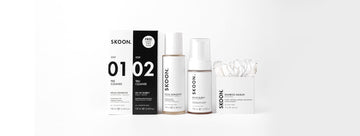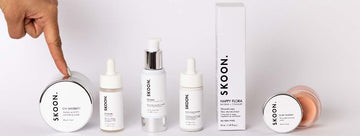Have you ever wondered…
Why your dry skin gets worse in winter?
Why flying makes your skin shrivel?
Why your skin feels so shrink-wrapped when you get out of that long and blissful, steamy shower?
What the difference is between dry and sensitive skin?
Why sugar is bad for you?
Sorry, the last question was a trick. Just wanted to check that you’re concentrating ☺.
Although, come to think of it, maybe it won’t be such a bad idea to do a “How sugar affects your skin” blog post – another one for my to-do list.
Let’s get back to the topic of dry and sensitive skin.
I’ll cover why your skin’s moisture (that was perfectly fine in autumn) gets so out of whack in winter. What SOS measures you can take to get it back to feeling smooth & bouncy.
For good measure I have also answered some popular questions at the end of the blog.
Off we go!
Table of contents
- What is dry skin?
-
Symptoms & types of dry skin
○ Why does dry skin flare up in Winter?
○ Why does my dry skin itch? - What is sensitive skin?
-
Symptoms of sensitive skin
○ What did I do to cause an impaired skin barrier?
○ Poor skin care routines cause skin barrier damage
○ Environmental factors can damage the skin barrier
○ Mature skin is prone to skin barrier damage
○ Other factors that can cause skin barrier damage
○ Can my skin barrier function be improved? - Treatments for dry and sensitive skin – step-by-step home program
-
Your top dry and sensitive skin questions answered!
○ Does dry skin cause wrinkles?
○ What kind of moisturiser is the best for dry skin?
○ Why does my skin get dry when I fly or go on a long road trip?
○ Does natural ageing cause dry skin?
○ Will it help if I exfoliate my dry skin?
○ Will a peel help my dry skin?
○ What is the number one product to avoid if you have dry skin?
○ Which ingredients are great for treating dry and sensitive skin?
What is dry skin?
(Chemistry alert!) Dry skin is caused by too much water escaping from the surface layers of your skin. This is called transepidermal water loss or TEWL for short.
Fortunately, we have our own built-in “dam wall” to keep skin moisture inside - called the skin barrier.
What is your skin barrier?
If you think of the surface of your skin as a brick wall (yes, I know this is a stretch but bear with me ☺), the cells are the bricks and your barrier lipid complex is the cement that holds everything together. (BTW - lipid is a fancy skincare term for oil).

Another way of thinking about this is to imagine that an oil-rich liquid fills the gaps between the cells the same way cement fills in the spaces between the bricks in a wall – and this forms a waterproof ‘wall’ or barrier.
Your skin gets dry when too much water or moisture escapes through this protective “wall” in the top layer of your skin. Your skin’s “dam” literally runs dry. This happens if your “wall’ is not in a good condition – in skincare terms we call this an “impaired barrier”.

Symptoms & types of dry skin
Once your “dam” is empty, your skin becomes water-dry (also referred to as dehydrated).
Water-dry skin has a papery texture with very fine wrinkles.
You can also experience flaking and peeling.
Lack of moisture in water-dry skin makes the appearance of wrinkles, rough texture and skin sagging look worse.
Oil-dry skin happens when skin is stripped of its protective lipid (oil) layer.
Vigorous cleansing with foam cleansers and over-peeling are two of the main reasons for oil-dry skin.
Why does dry skin flare up in winter?
The answer is quite straightforward. Cold, dry winter air sucks too much moisture through this protective “wall” in the top layer of your skin. Rapid loss of moisture will further impair your skin barrier. In other words, your skin barrier will be like a wonky wall with holes to keep your moisture in. This will naturally cause you to loose even more moisture. So starts the vicious winter skin cycle.
The result: typical winter dry skin – that feels like sandpaper.
Why does my dry skin itch?
‘Winter-itch’ is a classic symptom of an impaired barrier function (or wonky wall ☺). Your impaired barrier affects nerve endings, causing itchiness.
Take away fact: there is nothing you can do about winter – rather concentrate on optimising your lipid barrier complex and your skin barrier.
Let’s break with a coffee and a treat for a few minutes – today my sweet treat choice is a slice of Lemon Drizzle Cake (my 2nd absolute favourite).
Not that I want to digress but the SKOON. Vanilla & Blood Orange Solid Body Oil smells exactly the same as lemon cake and is just one of the reasons why I love it so much.
Now that we are sugar-charged again, let’s see what it means to have sensitive skin and how this ties in with dry skin.
What is sensitive skin?
Sensitive skin is defined as skin that is highly reactive to treatments and environmental factors. Interestingly, at least 40% of us consider ourselves to be in this category.
In addition to being more reactive, sensitive skin can also have barrier function defects which expose nerve endings to nerve irritants.
Quick example: If you eat an orange and have chapped lips, it stings. The acidic orange juice penetrates right through your protective skin barrier (“wall”) and hits a nerve ending, causing the stinging, burning feeling.
Burning, stinging and itching therefore go hand-in-hand with sensitive skin.
NOTE: A hypersensitive allergic reaction is something different and is often confused with having sensitive skin. A hypersensitive allergic reaction is the body’s immune system rejecting a particular substance (food, airborne substances or topical cosmetic ingredient). The skin is triggered to immediately respond to allergens by reddening (often a fine red rash), swelling, hives and so on. So hypersensitivity is not linked to an impaired skin barrier as in the case of sensitive skin.
All this, just to explain that if you have dry skin, winter skin or sensitive skin, the immediate call to action for all three is exactly the same. Optimise your skin barrier!
If you are still not sure, keep reading for symptoms of sensitive skin or simply use a quick checklist to find out if your skin barrier is in tip-top shape – or not ☹.

Symptoms of sensitive skin
If you have sensitive skin, you may experience burning, stinging and itching from time to time. In addition, redness and flakiness are also common complaints.
Conditions like rosacea and eczema are also classified as sensitive skin conditions with impaired barrier functions.
I know this is a lot to take in. I have made this short check list – please take it to determine if your barrier is impaired since there is a lot of overlapping between dry or sensitive skin and an impaired barrier.
Do I have an impaired skin barrier? A quick check list
Here’s my simple check-list (I filled mine in as an example) to help determine whether your skin barrier needs some TLC.
1 - No symptoms | 2 - Occasionally | 3 - Often | 4 - Very active | 5 - Drives me insane!
| Flaking – Loose skin flakes due to excessive dryness. | 1 2 ❸ 4 5 |
| Tightness- Pulling sensation - as if there is not enough skin to cover your face, often experienced after a shower or bath. | 1 2 3 ❹ 5 |
| Redness – Inflammation because the barrier is unable to stop moisture from escaping and irritants from penetrating the skin. | 1 2 ❸ 4 5 |
| Itchiness – Classic winter itch when a damaged barrier doesn’t protect nerve endings. | 1 2 3 4 ❺ |
| Stinging & Burning – Sensation caused by irritated and inflamed nerve endings. | 1 ❷ 3 4 5 |
If you score 3 or more for two (or more) of the five categories you should consider a routine that’ll restore your skin barrier.
What did I do to cause an impaired skin barrier?
So now you may wonder why you have a “wonky wall” for a skin barrier and if it is something you are doing wrong.
Not always – but let’s look at all the reasons your barrier may not be up to scratch.
Poor skin care routines can cause skin barrier damage
As mentioned above, over-cleansing (with harsh, foam cleansers) and over-peeling are two of the main culprits that destabilise your skin barrier. This is especially true if you have an oily/combination skin.
Washing too vigorously or too often depletes your natural protective oils in your lipid barrier matrix which will cause your skin to become oil-dry, and then water-dry and in the end you will simply have a skin that is both too oily and too dry (and often inflamed also).

Environmental factors can damage the skin barrier
Exposure to elements, especially cold, dry air and wind can damage the lipids in your lipid barrier matrix.
Cumulative sun damage from years of sun exposure will also affect your cell renewal cycle. Since this is where your skin naturally produces lipids (oil) for your lipid barrier matrix a slow cycle = less lipids (oil) = an impaired barrier.
BTW - This is the reason why I always cover my skin with an oil-rich product like RUBY MARINE Overnight hydrating mask before I go for long walks in winter.
Mature skin is prone to skin barrier damage
Not sure if I am the only one here but I have never really liked the word mature ☺. It never bodes well.
As we grow older our bodies change. We slow down. So does our skin and all of its vital processes, including the production of vital oil to keep our lipid barrier matrix healthy.
So in a nutshell, age will dry out your barrier and your skin!
Other factors that can cause skin barrier damage
Medication is often overlooked when it comes to causes for dry skin.
A variety of medication can dry your skin out but antihistamines and acne medication (Accutane, Oratane and even topical retinoids) are two that particularly affect oil production and by definition your lipid barrier matrix and skin barrier.
Let’s not forget the reason why you are taking medication in the first place. Underlying medical conditions can have a huge impact on your skin.
Last but certainly not least, if you are not sleeping well your skin is going to be dry. Dull and dry.
Can my skin barrier function be improved?
Good question! Yes, absolutely!

Back to the oily liquid called your barrier lipid matrix that acts like glue between your cells. The best way to restore the balance of your impaired barrier is to top-up the missing lipids (oils) in your matrix.
Natural skincare is not a quick fix. Personally, I think it’s actually better. The wonderful, rich and nutritious buyers and plant oils are perfect to support the lipids in your skin barrier while it rebalances on its own.
At SKOON. we firmly believe healthy skin is happy skin.
Treatments for dry and sensitive skin – step-by-step home program
There is no one-fits-all skincare at SKOON. but this is an easy to follow guide to improving your skin barrier – feel free to use it as a starting point and customise for your own unique skin needs.
AM:
Step 1 – THE MOST IMPORTANT STEP
Take your foaming cleanser and chuck it in the bin.
Step 2 – CLEANSE
Use a soft muslin cloth and lukewarm water to gently clean your face. Soft patting movements, no sanding of skin!

Step 3 – MOISTURISE
Apply a protective emollient – WRAP ME UP Therapy face cream is perfect for this.
Step 4 – LOCK-IN WITH OIL OR BALM
Lock your moisturiser in with a 100% natural plant oil concentrate (ROSEHIP C +, GLOWDROPS or SQUALANE) or alternatively an oil-rich balm - a tiny scoop of RUBY MARINE is all you need.
NOTE: If your face looks as shiny as a glazed donut, you know you are on the right track. The oils and butters will blissfully seep into your skin. Give it about 5 minutes.

PM:
Step 1 – THE 2nd MOST IMPORTANT STEP
Feel no pain as you glance at your foaming cleanser lying in the bin ☺.
Step 2 – CLEANSE
Use a soft muslin cloth and a small scoop of NKUTO Butter to gently clean & polish your face.
Nkuto is the perfect sealant against the drying effects of hot water and steam.
For effective skin protection, apply it generously before you jump into the bath or shower.

Step 3 – MOISTURISE
Apply a protective emollient – WRAP ME UP Therapy face cream is suitable for morning and evenings.
Step 4 – LOCK-IN WITH OIL OR BALM
Lock your moisturiser in with a few drops of our lovely 100% natural plant oil concentrates (ROSEHIP C +, GLOWDROPS or SQUALANE) or a tiny scoop of RUBY MARINE Overnight hydrating mask, same as in the morning.
Wait for a few minutes to allow the oils and butter to seep in before you jump into bed.
I thought I’d end my blog with popular questions I always get asked about dry skin. (And a final slice of lemon cake).
Your top dry & sensitive skin questions answered!
Does dry skin cause wrinkles?
Mostly, dry skin just makes wrinkles look worse. Deeper wrinkles are primarily caused by facial expressions, sun damage and a reduction in skin elasticity due to ageing.
What kind of moisturiser is the best for dry skin?
A moisturiser that is formulated to specifically support your skin barrier lipid matrix, calm redness and hydrate, hydrate, hydrate ☺.
SKOON. has launched WRAP ME UP Therapy face cream – the actual bomb when it comes to dry skin. Read more here on how to lavish your dry and sensitive skin with true love ♥.

Why does my skin get dry when I fly or go on a long road trip?
Dry, recycled cabin air (or air-conditioning in the car) sucks moisture from your skin. Simply lock your moisturiser in with an oil-rich balm like RUBY MARINE Overnight hydrating mask pre-trip. On a long flight or drive, reapply at least once more.
SKOON. introduced the mini pots for this very reason. Easy to pop one into your bag and enjoy your trip.
(I know it feels like we are never going to travel again with COVID19 but I feel optimistic that we will soon feel the excitement of booking in again.)
Does natural ageing cause dry skin?
Yes, definitely. Cell turnover slows around the age of 40. Unfortunately, it is this vital cell renewal cycle that tops up your barrier lipid matrix. Less lipids (oils) mean a less effective barrier and by now I am sure you know this means more moisture will escape from your top skin layers. Naturally, the end result is dry/drier skin.
Hormones (lack thereof!) and sun damage over the years also play a big part in drying your skin as you age.
Will it help if I exfoliate my dry skin?
It makes sense to speed up sluggish cell renewal if you are older (see above question). As long as it is done gently – so no harsh mechanical scrubs, please!
A simple way is to use a targeted moisturiser that contains a gentle, natural exfoliant e.g. salicylic acid, that achieves this on a daily basis without overdoing it.
Will a peel help my dry skin?
I would not recommend a peel if your skin is cracked or inflamed.
What is the number one product to avoid if you have dry skin?
Foaming cleansers. (Sure you guessed this one)
Which ingredients are great for treating dry and sensitive skin?
Look out for target specific products that contain nutritious oils and butters, anti-inflammatory actives, soothing botanicals with supporting clinical trials and barrier repair blends (a combination of all three: free fatty acids, sterols and ceramides).
Like I said earlier, SKOON.’s new WRAP ME UP Therapy face cream is the bomb for barrier repair. It contains all of these actives and more.

Safflower oil, Pomegranate sterols and Ceramide III – the unique natural barrier repair blend that improves barrier function
Safflower oil is mega rich in Linoleic Acid, also called omega 6 fatty acids. Studies have shown that topical application of skin friendly, omega 6-rich Safflower Oil normalises TEWL (Trans Epidermal Water Loss) and reduces scaliness after 14 day of application.
Sunflower Seed Unsaponifiables - noble molecules from linoleic sunflower oil that act as a intelligent moisturiser
The precious molecules from sunflower seeds electively stimulate the synthesis of key lipids in your barrier lipid matrix and soothes redness.
Magnesium Carboxymethyl Beta-Glucan - Personal trainer to strengthen sensitive skin
The ultimate ingredient. Magnesium Carboxymethyl Beta-Glucan rebalances the skin’s immune system, soothes irritated skin and itching. This award winning active is known to alleviate skin discomfort in less than one week.
Schisandra Extract - anti-redness & skin tone unifying
Extracted from vibrant, red schisandra berries this powerhouse extract is extremely effective at reducing redness. Not to mention, it’s also 100% natural ☺.
Fulvic Acid – powerhouse anti-redness ingredient
Carbohydrate-Derived Fulvic Acid (CHD-FATM) aids in neutralising unwanted toxins and carries nutrients to skin cells. Improved cell metabolism results in reduced inflammation.
Hyaluronic Acid – a powerful humectant
This amazing little molecule forms part of our skin’s own NMF’s (Natural Moisturising Factors) and can retain up to 1000 times its own weight in moisture! It penetrates deep down into the skin's layers to ensure proper skin hydration.
Hyaluronic Acid strengthens the skin barrier and improves moisture retention. within the skin. Learn more about the benefits of hyaluronic acid for multiple skin types.
Congratulations for making it all the way here.
I hope you enjoyed this blog and would love to hear what you think, and if you have any questions about dry and sensitive feel free to post them in the comments section.
As many of you know by now, I love a 2-way conversation. Your comments are not only appreciated but I feel that many and various views add up to a richer perspective and beneficial discussions.







Good day
Does your wrap me up moisturizer contain any essential oils as I am extremely sensitive to strong smells and on my skin.
Regards
Hi,
I purchased the Starter Kit for sensitive skin the Retinal moisturiser as I have mature sensitive skin and rosacea – the type that manifests as acne. I’m a 57 year old with teenage zits!
What do you recommend as a longer term solution? I like the sound of your WrapMeUp moisturiser. Should I buy this instead of the sample Phyto Light in the starter kit?
Thanks!
Such an informative article. Thank you for explaining it so easy
Hi
thank you for clearing up a lot questions. your products are great.
what i am confused about is what must be applied first? Moisturiser than the oil (i used to do it the other way around?
I just bought your cleanser. would you say that the butter would be better than your cleanser for very dry sentive skin?
Awaitting your reply
Regards
Lynnette Barnard
PS Please work on the eye area (dark circles, puffiness and dryness) and also on a spf30+ to apply above the skin care
Hi.
Could you perhaps explain why you would first moisturize (step 3) and then apply oils (Eg. Rosehip) and not the other way around?
I was under the impression that active ingredients go before moisturizer as that then locks it in.
Still quite new to the skincare world and love learning new things!
I too have dry and sensitive skin and purhased your wow wow wonder serum, rosehip C concentrate as well as ruby marine overnight mask. Starting using it this week – love the feeling on my skin and excited to see the results!